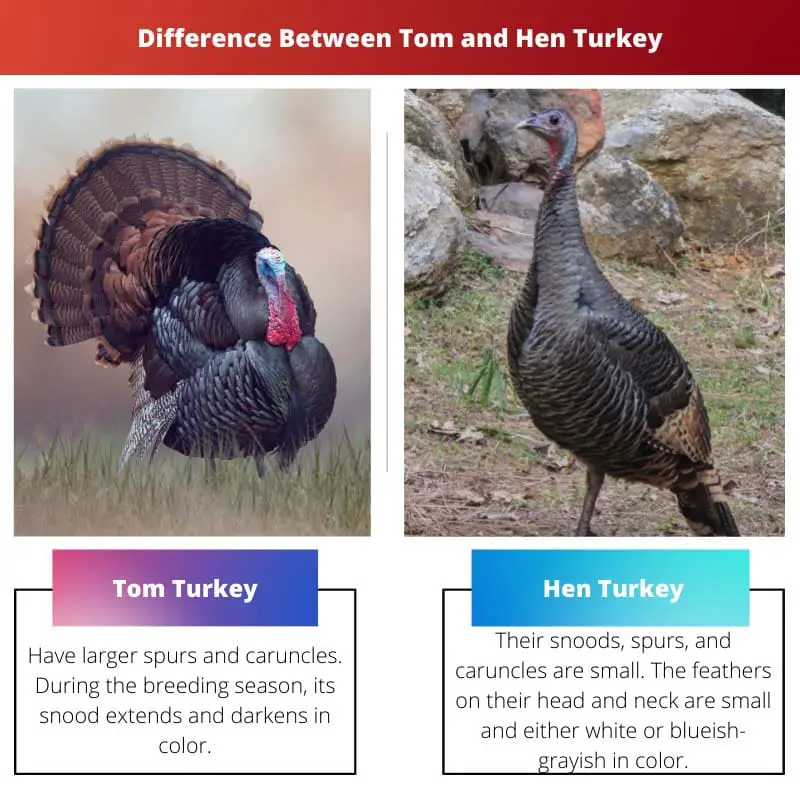Are you prepping to host a memorable Thanksgiving dinner but can’t decide on the type of turkey you need for the table?
From selecting the desired size to deciding whether to buy a frozen or a fresh one, cooking a delicious turkey requires a lot of thought to be put into it.
Key Takeaways
- Tom turkeys are male turkeys, while hen turkeys are female turkeys.
- Tom turkeys have larger bodies, feathers, and snoods than hen turkeys.
- Hen turkeys have a higher meat-to-bone ratio compared to tom turkeys.
Tom Turkey vs Hen Turkey
Tom turkeys, also known as male turkeys, are larger than hens and have more colorful and prominent feathers, particularly during the breeding season. Hen turkeys are smaller, have duller feathers, are kept for egg-laying, and their meat is considered to have a richer flavour than that of toms.

Tom turkeys are matured male turkeys and are also known as Gobblers. A tom turkey weighs between 8 to 10 kgs and ideally matures within 20 weeks.
A hen turkey is reared for 12 to 16 weeks and weighs between 3 to 7 kg. However, if a hen turkey weighs about 10 to 12 kg, it develops a layer of fat that adds a flavour to the turkey on being roasted.
Comparison Table
| Parameters of Comparison | Tom Turkey | Hen Turkey |
|---|---|---|
| Gender | Male | Female |
| Size and Weight | Big and weighs within 8 to 10 kgs | Relatively small and weighs between 10 to 12 kgs |
| Physical Appearance | Have larger spurs and caruncles. During the breeding season, its snood extends and darkens in color | Their snoods, spurs, and caruncles are small. The feathers on their head and neck are small and either white or blueish-grayish in color |
| Color of Feathers | Black in color with hues of bronze, copper, gold, green, blue and red | Brownish in color with buffy, gray, or white-tipped breast feathers |
| Bone to Meat Ratio | Have larger bones and less meat | Have small bones and is meatier |
What is Tom Turkey?
Tom turkeys are adult male turkeys. Along with making about 30 types of calls, a tom turkey is also called a Gobbler as it makes gobble sounds.
A full-grown tom turkey is black with iridescent gold, bronze, copper, red, green, and blue hues. It has big caruncles that are fleshy, with red bumps covering its neck and head.
This is its most striking physical feature because, during the breeding season, the snood extends past the beak and darkens in color depending on the turkey’s level of excitement.
They also have beards that are 5 to 12 inches long in an effort to please the hen turkey, the tom turkey fans out its tail feathers magnificently.
Not all tom turkeys can sire poults. Only the dominant ones can sire, whilst the subordinate tom turkey assists the dominant one in mating.
Cooking a tom turkey would mean that the bones will be bigger and the meat little. However, the meat will be tender if the turkey isn’t too old.

What is Hen Turkey?
A hen turkey is an adult female turkey. It is smaller than a tom and weighs about 3 to 7 kg. It takes approximately 12 to 16 weeks to rear up a hen turkey.
They are not as attractive as their male counterpart. Hen turkeys are brown and have grey or white-tipped breast feathers.
Unlike the tom, the hen turkeys cannot extend their snoods but find males with longer, larger, and brighter snoods more appealing as it is an indicator of being physically fit.
The females are capable of laying nine to thirteen eggs. The healthier hen turkeys nest earlier in comparison to females who aren’t in good condition.
Ideally, a hen turkey should weigh between 3 to 7 kgs, but if it weighs around 10 kgs, it suggests that the turkey has developed a layer of fat which, after being roasted, adds a juicier texture and flavour to the meat.

Main Differences Between Tom and Hen Turkey
- A tom turkey grows faster in its early days and has relatively low mobility. In contrast, a hen turkey’s growth in the initial days isn’t as rapid as a tom’s and has high mobility.
- While only the dominant tom turkeys can sire poults and the subordinate tom turkeys can only assist the former in mating, all hen turkeys can lay eggs.

- https://www.sciencedirect.com/science/article/pii/S0032579119306297
- https://www.sciencedirect.com/science/article/pii/S1056617119313819

The scientific rigor and academic quality of the content are evident, making this piece a valuable source for those interested in zoology and culinary science.
The interdisciplinary approach adopted in this article has undoubtedly elevated the discussion on turkey biology and its culinary implications.
I concur, the seamless integration of biological and gastronomic insights has rendered this content exceptionally informative and engaging.
It is evident that the content has been derived from credible sources, and the research behind it is highly reliable.
Yes, the scientific references included have undoubtedly added depth and validity to this informative piece.
The references confirmed the accuracy of the information and made the article more intellectually stimulating.
The biological differences, as well as the behavioral distinctions between the genders, have been elucidated precisely, providing valuable insights.
Absolutely, this content transcends beyond the typical culinary discourse and delves into the scientific underpinnings of the gender differences in turkeys.
The distinctions between Tom and Hen turkeys can significantly impact the preparation and cooking methods, and this article has effectively emphasized those differences.
The insights into the bone-to-meat ratio are particularly helpful for those aiming to master the culinary aspects of turkey preparation.
Completely agree, the information provided is essential for individuals who are particular about their turkey selections.
The scholarly nature of this article is truly commendable, and its delivery of factual discourse sets a high standard for content of this nature.
The clarity with which the gender-specific characteristics have been presented indicates the intellectual rigor that has gone into the creation of this content.
The content reflects an intellectual acumen, providing both informative and thought-provoking insights into turkey physiology and behavior.
Indeed, this article offers a sophisticated and nuanced perspective on the gender distinctions between turkeys.
The detailed comparison table provided a very clear insight into the unique characteristics of Tom and Hen turkeys.
Absolutely, the article has done an excellent job in outlining the distinctions between the two turkey genders and their relevance to cooking.
The accuracy and depth of the information provided reflect the high intellectual caliber of this content, which greatly contributes to the reader’s understanding.
Absolutely, the precision and thoroughness of the data have been extremely beneficial in enriching our knowledge about turkeys.
This content exemplifies an exceptional level of intellectual discourse, making it a commendable source for those seeking comprehensive insights.
The comprehensive overview of the unique turkey characteristics aids in building a deeper understanding of the differences that influence our culinary choices.
I found this article particularly fascinating due to its focus on both the physical and nutritional disparities between Tom and Hen turkeys.
Absolutely, the in-depth analysis of these traits significantly enhances our knowledge regarding turkey selection and cooking.
The article provided has been comprehensive in describing the differences between Tom and Hen turkeys, particularly focusing on the behavioral, physical, and nutritional aspects of both genders.
I completely agree, I also found the information presented to be very well-researched and informative.